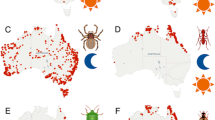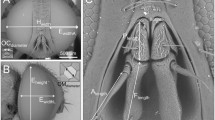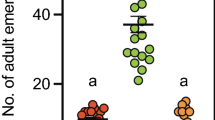Abstract
ADULT parasitic wasps need nectar or some other fragrant food source1,2, but the effect of food odours on their behaviour has not been investigated to any extent3. Females of the parasitic wasp Microplitis croceipes learn volatile odours associated with host sites and use them to find hosts more effectively4,5. We have now performed flight tunnel experiments that show that this wasp also uses airborne odours to find food sources. Females learn associatively and subsequently fly to volatile odours presented for smell while they are feeding on sugar water. Furthermore, they can learn two novel odours associated with separate host and food resources and then make an accurate choice between these odours on the basis of their relative host and food needs. This ability of parasitic wasps to link different odours with specific resources and then effectively to use them as cues for choice between competing needs is of fundamental and applied importance.
This is a preview of subscription content, access via your institution
Access options
Subscribe to this journal
Receive 51 print issues and online access
$199.00 per year
only $3.90 per issue
Buy this article
- Purchase on Springer Link
- Instant access to full article PDF
Prices may be subject to local taxes which are calculated during checkout
Similar content being viewed by others
References
Leius, K. Can. Entomol. 42, 369–376 (1960).
van Emden, H. F. Entomol. Mon. Mag. 98, 265–270 (1963).
Vinson, S. B. in Comprehensive Insect Physiology Biochemistry and Pharmacology (eds Kerkut, G. A. & Gilbert, L. I.) 417–469 (Pergamon, Oxford, 1985).
Drost, Y. C., Lewis, W. J., Zanen, P. O. & Keller, M. A. J. chem. Ecol. 12, 1247–1262 (1986).
Lewis, W. J. & Tumlinson, J. H. Nature 331, 257–259 (1988).
Arthur, A. P. in Semiochemicals, Their Role in Pest Control (eds Nordlund, D. A., Jones, R. L. & Lewis, W. J. (Wiley, New York, 1981).
Vet, L. E. M. Neth. J. Zool. 33, 225–248 (1983).
Vinson, S. B., Barfield, C. S. & Henson, R. D. Physiol. Entomol. 2, 157–164 (1977).
Gould, J. L. in The Biology of Learning (eds Marler P. & Terrace, H. S.) 149–180 (Springer, Berlin, 1984).
Palmerino, C. C., Rusiniak, K. W. & Garcia, J. Science 208, 753–755 (1980).
Author information
Authors and Affiliations
Rights and permissions
About this article
Cite this article
Lewis, W., Takasu, K. Use of learned odours by a parasitic wasp in accordance with host and food needs. Nature 348, 635–636 (1990). https://doi.org/10.1038/348635a0
Received:
Accepted:
Issue Date:
DOI: https://doi.org/10.1038/348635a0
Comments
By submitting a comment you agree to abide by our Terms and Community Guidelines. If you find something abusive or that does not comply with our terms or guidelines please flag it as inappropriate.



